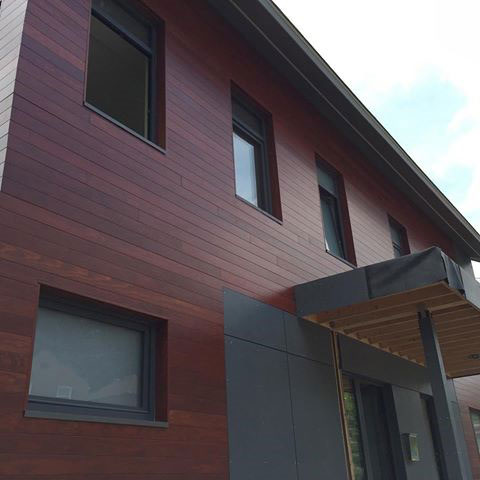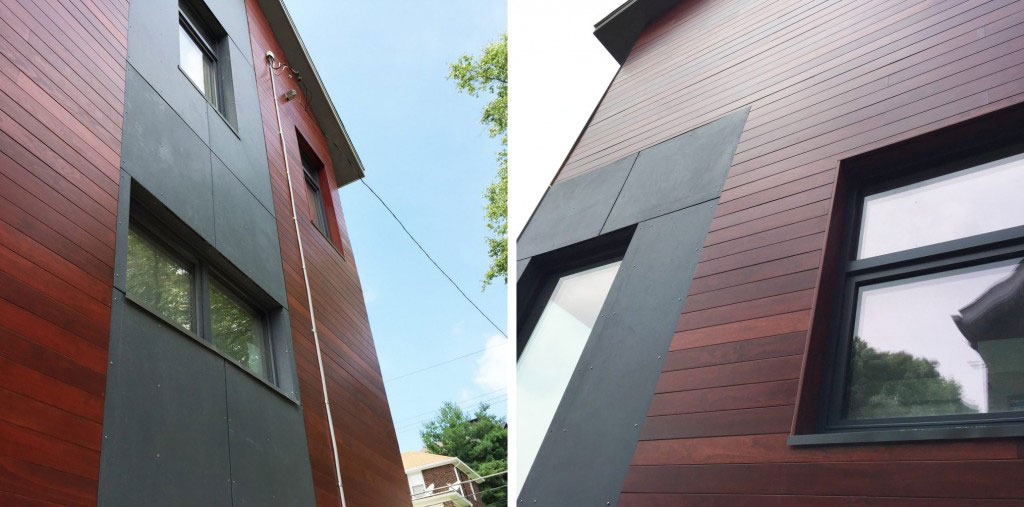Now that three coats of permeating and sealing stains are on the Accoya wood siding of her nearly finished duplex in Pittsburgh’s upscale Squirrel Hill community, homeowner Lucyna de Barbaro, who did the painting herself, says the exterior walls are “too good to be true.”
The rich, reddish-brown hue of the finished siding isn’t the only feature of the shiplap-patterned outer walls that has the hands-on homeowner impressed, however. The product’s durability, long warranty and low carbon footprint initially attracted the physicist and her physics-professor husband to the cladding on the exterior of the ultra-energy efficient passive house.
“We were very impressed with the fact that the wood is used for building bridges and other projects that normally you wouldn’t dare to build with ordinary wood,” says de Barbaro, who will move with her husband into one of the home’s two units when construction wraps up this spring. “Its promise of durability and its warranty make a big difference here.”

In fact, every material used in the building of the 4,600-square-foot dwelling was selected because of its environmental friendliness. The home, which features one four-bedroom unit and another with two bedrooms and a studio, is packed with passive building features like 13-inch-thick walls, rock wool insulation, triple-pane windows, highly sustainable joints and seam fluid, and a stormwater collection system. The owners are aiming to win a National Green Building Standard Certification and a nod from Passive House Institute U.S.
The duplex will be the first certified passive house in Squirrel Hill and one of just half a dozen in the Pittsburgh area, notes lead architect Erik Fritzberg of Dunn and Associates, who estimates the abode’s heat recovery and ventilation systems will be 92 percent efficient and that the house will use about as much energy as a hair dryer to heat and cool.
Fritzberg, a certified passive house consultant, says the home is four times more energy efficient and 10 times better sealed than an Energy Star-certified home. “It’s almost airtight, like a thermos,” explains de Barbaro, who says the home sports a small heat pump in case “our own bodies and the refrigerator” can’t keep the indoor air temperature cozy enough.
Outdoors, Fritzberg wanted a durable product that—unlike cedar and some other high-end woods—would hold its color over decades of Pittsburgh winters, which are frigid, damp and cloudy. He selected Accoya on the recommendation of the project’s siding contractor, who had used the product on a rooftop deck at a nearby home. And he paired it with fiber cement for variety and “to add a little playfulness to it … so [the exterior] wasn’t one repetitious color or material.” De Barbaro approved the wood selection—unique in a neighborhood of brick homes—in part because it is renewable and manufactured with less energy than brick requires.
The result, Fritzberg says: The siding “looks like floor boards—really beautiful. It’s very nice-looking stuff.”

It’s also reliable, says Steve McManus, owner of Leaf Redevelopment, the siding contractor. “We believe we should make things that last as long as possible, and Accoya fits great within that,” he says. And his experience with the Accoya-wood deck he built surpassed his expectations for the alternative—pressure-treated lumber—which can trigger “callbacks, splits, warps, dryness, inconsistent quality,” McManus notes. “This is a more desirable building product.”
And the home, which cost $800,000 to build, is more desirable than her neighbors’, de Barbaro says. “We have a huge specialty here. It’s a unique house with a high level of detailing that went into it. … It’s stunning.”
PROJECT DETAILS
Building Type: Residential
Completed: 2016
Architect: Dunn and Associates
Siding Contractor: Leaf Redevelopment
Distributor: Snavely Forest Products
